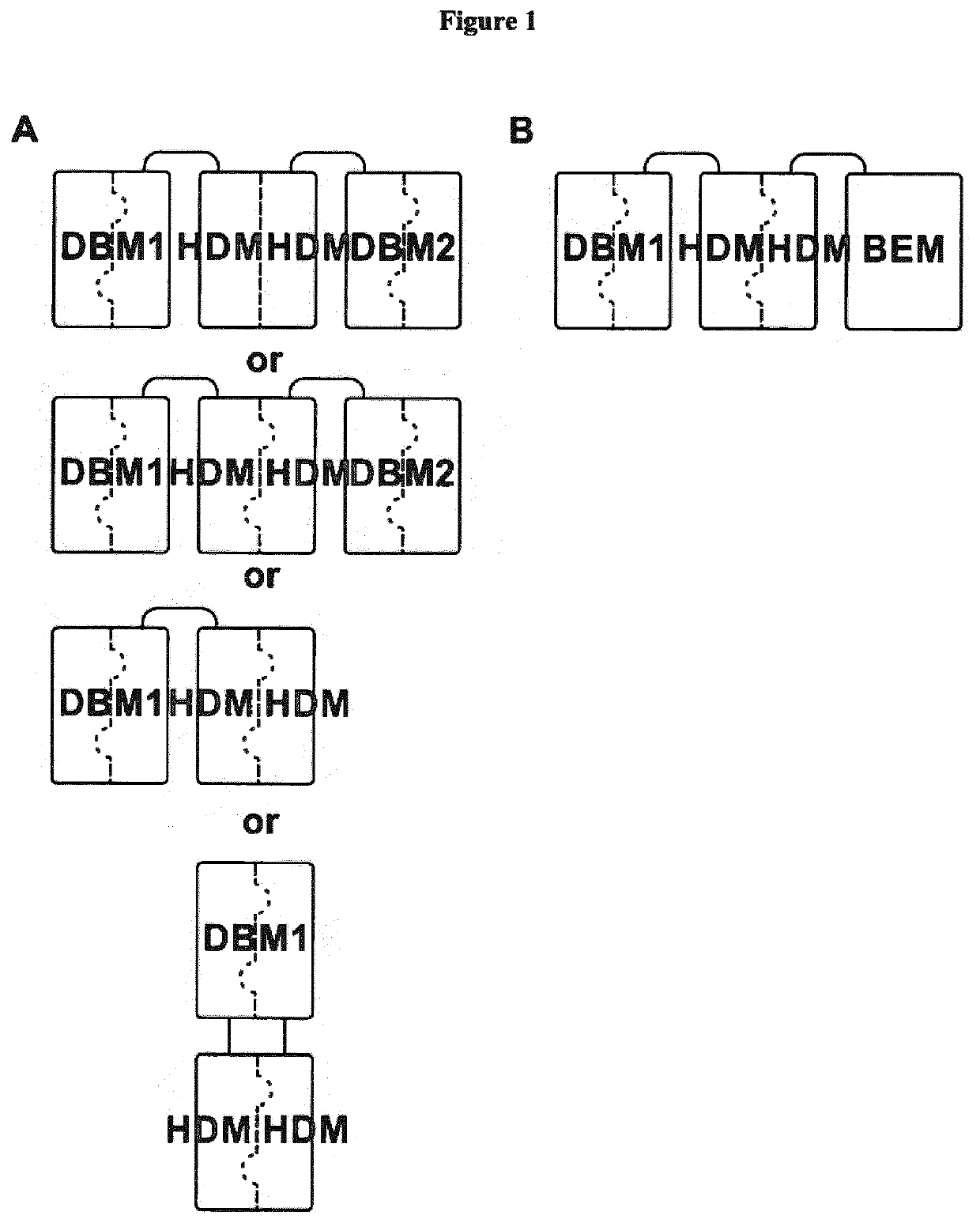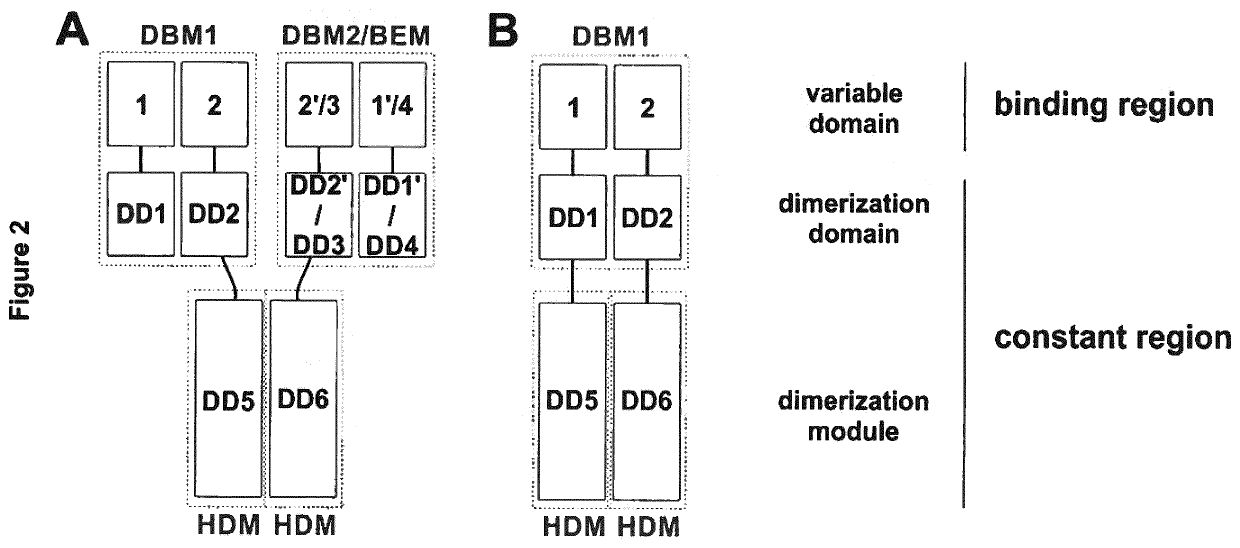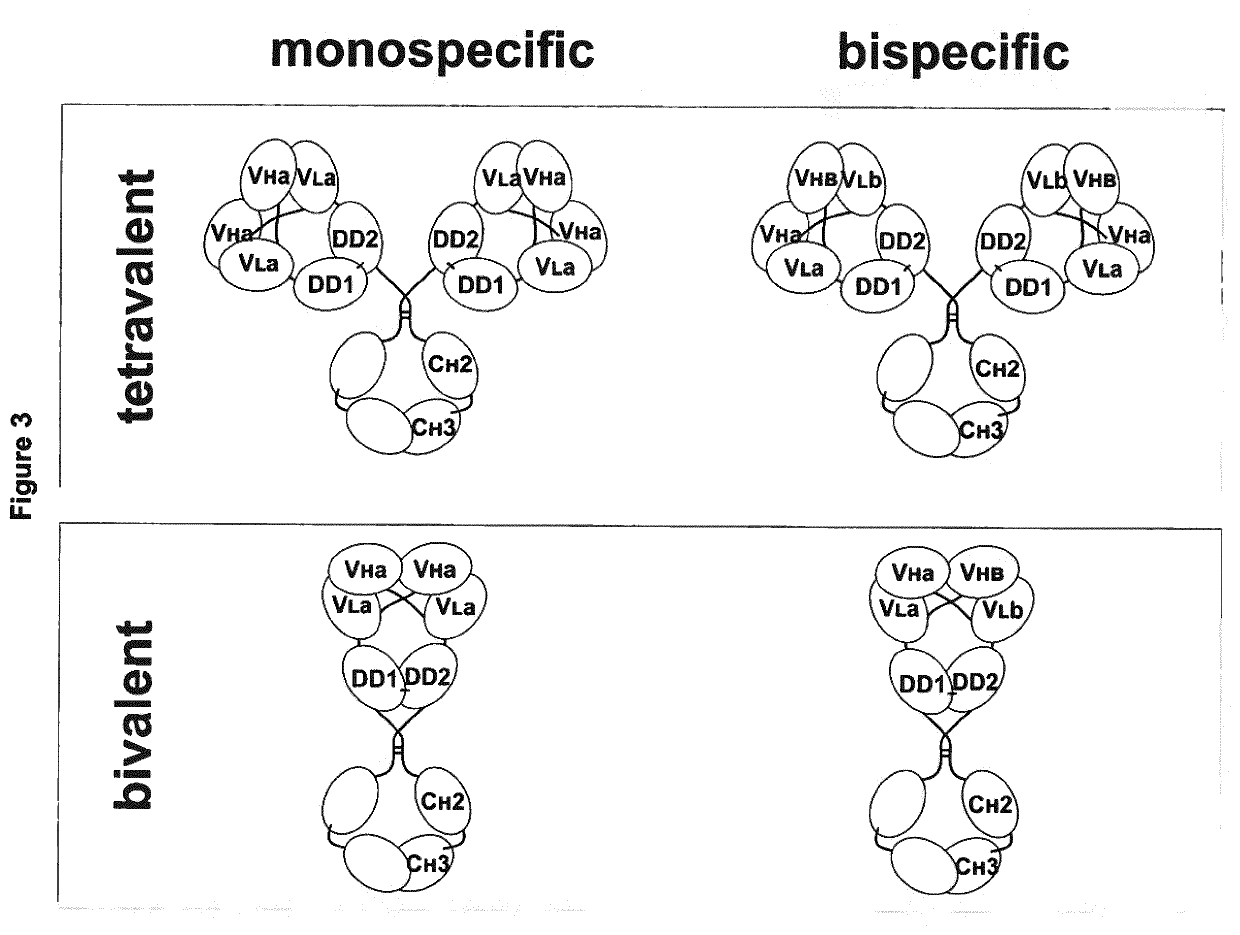Multivalent binding molecules
a multi-functional, binding technology, applied in the direction of antibody medical ingredients, instruments, peptide/protein ingredients, etc., can solve the problem that monoclonal antibodies targeting only a single antigen have limitations
- Summary
- Abstract
- Description
- Claims
- Application Information
AI Technical Summary
Benefits of technology
Problems solved by technology
Method used
Image
Examples
embodiments
[0145]In the following different aspects of the invention are defined in more detail. Each aspect so defined may be combined with any other aspect or aspects unless clearly indicated to the contrary. In particular, any feature indicated as being preferred or advantageous may be combined with any other feature or features indicated as being preferred or advantageous.
[0146]In a first aspect, the present invention provides an antigen-binding protein complex comprising at least one dual binding module (DBM), and one homo- or hetero-dimerization module (HDM) and optionally a binding or effector module (BEM), wherein[0147]a. a first DBM module (DBM1) comprises two polypeptides, wherein the first polypeptide (P1) comprises a first dimerization domain (DD1) and a first variable heavy chain (VH1) and a first variable light chain (VL1), wherein said VH1 and VL1 are connected by a peptide linker (L1), with a length preventing binding of VH1 and VL1 to each other, and the second polypeptide (P2...
example 1
cific and Tetravalent Diabody-Ig (Db-Ig) Targeting Death Receptor 5 (DR5)
[0327]A monospecific, tetravalent DbDR5xDR5-Ig molecule was generated by combining a Db molecule, specific for DR5 (variable domains originate from Drozitumab), with the constant domains of an IgG antibody. Thus, the DbDR5xDR5-Ig molecule consists of two different polypeptides, VHDR5xVLDR5-CL (light chain) and VHDR5xVLDR5-CH1-CH2-CH3 (heavy chain) (FIG. 26A). The monospecific, tetravalent agonistic DbDR5xDR5-Ig exhibits four antigen binding sites for DR5 (FIG. 26B).
[0328]The binding molecule was expressed in transiently transfected HEK293-6E cells after co-administration of two plasmids, using polyethylenimine (PEI) as transfection reagent. The plasmids for transfection are based on pSecTagA (Invitorgen). One day before transfection, 1·106 cells per ml were seeded in FreeStyle F17 Expression Medium supplemented with 4 mM GlutaMAX (Thermo Fisher Scientific) and 0.1% kolliphor P188, overnight shaking with 115 rpm...
example 2
cific and Tetravalent Diabody-Ig (Db-Ig) Activating TNF-Receptor 2 (TNFR-2)
[0329]A monospecific, tetravalent DbTNFR2xTNFR2-Ig molecule was generated by combining a Db molecule, specific for TNFR2 (variable domains originate from IgG15), with the constant domains of an IgG antibody. Thus, the DbTNFR2xTNFR2-Ig molecule consists of two different polypeptides, VHTNFR2xVLTNFR2-CL (light chain) and VHTNFR2xVLTNFR2-CH1-CH2-CH3 (heavy chain) (FIG. 27A). The monospecific, tetravalent agonistic DbTNFR2xTNFR2-Ig exhibits four antigen binding sites for TNFR2 (FIG. 27B). DbTNFR2xTNFR2-Ig was expressed in transiently transfected HEK293-6E cells after co-administration of two plasmids encoding for the light chain and the heavy chain, using polyethylenimine as transfection reagent. Protein secreted into cell culture supernatant was purified using CH1-CaptureSelect affinity chromatography. SDS-PAGE analysis revealed two bands under reducing conditions at approximately 65 kDa and 35 kDa corresponding...
PUM
| Property | Measurement | Unit |
|---|---|---|
| molecular mass | aaaaa | aaaaa |
| temperature | aaaaa | aaaaa |
| concentration | aaaaa | aaaaa |
Abstract
Description
Claims
Application Information
 Login to View More
Login to View More - R&D
- Intellectual Property
- Life Sciences
- Materials
- Tech Scout
- Unparalleled Data Quality
- Higher Quality Content
- 60% Fewer Hallucinations
Browse by: Latest US Patents, China's latest patents, Technical Efficacy Thesaurus, Application Domain, Technology Topic, Popular Technical Reports.
© 2025 PatSnap. All rights reserved.Legal|Privacy policy|Modern Slavery Act Transparency Statement|Sitemap|About US| Contact US: help@patsnap.com



